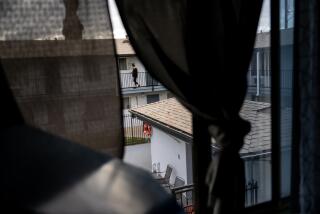CalPERS likely to fall short of annual investment goals

The California Public Employees’ Retirement System earned only 3% in the 10 months that ended April 30. Above, Ted Eliopoulos, CalPERS’ chief investment officer.
The nation’s biggest public pension fund is falling far short of its annual investment goals, a setback for a system already straining to keep up with looming obligations.
The California Public Employees’ Retirement System earned only 3% in the 10 months that ended April 30 and is likely to fall short of its 7.5% annual target when the fiscal year ends Tuesday, the pension giant’s investment chief said.
Absent a “remarkable rally in the global stock market,” said Ted Eliopoulos, CalPERS’ chief investment officer, the ground to make up in two months is too great to avoid a likely shortfall.
“We don’t like to get too excited about any one-year return,” he said. “As the board is well aware, we would like to look at longer time periods as they are much more meaningful in measuring our performance.”
Eliopoulos’ remarks came in a prepared statement to the CalPERS board last week. A video of the public meeting was posted on YouTube, but not yet on CalPERS’ website. CalPERS posted monthly financial data Thursday.
The performance of CalPERS, with investments totaling $304.9 billion at the end of April, is closely watched in the financial world and has broad implications for California taxpayers.
Charged with paying benefits to 1.7 million current and future retirees, CalPERS has the power to compel government employers to make up any shortfall in its fund. The pension plan was only 77% funded at the end of last June.
An 80% funding level had long been considered adequate, but a growing sentiment is calling on public pensions to be fully funded. The American Academy of Actuaries said pensions should set long-term goals of 100% funding or greater.
A 10-month financial report posted on the CalPERS website Thursday showed that the fund’s 3% return was nearly half a percentage point below the benchmark for other large pension funds.
The fund’s global stock portfolio, which represents about 54% of the fund, returned 3.1% in the period, slightly below a benchmark that grew 3.4%, according to the report.
The bond portfolio, the other big piece accounting for nearly 19% of the fund, turned in a strong performance in a volatile year, returning 4.3%, or nearly nine-tenths of a percentage point better than the benchmark.
The big underperforming category so far this year has been real assets, which account for 10% of the fund, according to the report. The category, dominated by commercial real estate, gained 3.7%, which was 4.7 percentage points below its benchmark.
Real estate returned 3.3% in the period, a time when property values generally were making strong gains in continuing to recover from the 2008 financial crisis, and missed the benchmark by more than 5.6 percentage points.
“I’m dumbfounded to understand returns of 3.3%,” said Craig Leupold, president of Green Street Advisors, a Newport Beach real estate research firm. “This is in the context of a commercial real estate background that has been quite healthy.”
Leupold said rents and building occupancy rates have been rising across property types, including shopping malls, offices, apartment buildings and warehouses. Green Street’s commercial property price index is up 12% in the 12 months that ended May 30 and gained 3% in May alone.
Joe DeAnda, a CalPERS spokesman, said return valuations of the fund’s private asset classes, including real estate and private equity, typically lag behind other assets since they require annual appraisal by investment advisors.
The returns for both asset classes are expected to come in substantially higher, he said, when the full-year numbers are reported in July and revised when the system’s annual report is published late this year.
Forest land, a small part of real assets, returned 3.1%, missing the benchmark by more than 5 percentage points.
In his remarks, Eliopoulos noted that the fund’s return last year was 18.4% and that it has been 10.8% annualized over three years, 9.5% over five years, 6.7% over 10 years and 8% over 20 years.
Michael Rosen, a principal at Angeles Investment Advisors, which counsels institutional investors, said the year-to-date performance was “not outside the bounds of what might be reasonable.”
But others said CalPERS’ looming miss adds to concerns about whether its return target is realistic and whether achieving it would be enough to forestall the need for ever-greater contributions from state and local governments to meet the system’s obligations.
The system’s target is a difficult one, said Sam Stovall, U.S. equity strategist for S&P Capital IQ. He noted that since 1918, the price of publicly traded stocks, which provide higher returns historically than bonds, has risen only 6.5% annually by one measure called the rolling 10-year compound growth rate.
Though dividends add to the total return for stocks, he said, “even if you put 100% into stocks, it might be a challenge to meet that 7.5% target.”
David Crane, an advisor to former Gov. Arnold Schwarzenegger and critic of the pension system, said the fact that the fund returned nearly half a percentage point below the benchmark was a “pretty significant” miss.
Crane said public pension accounting rules allow the system to dramatically understate liabilities and mask the size of the returns needed from its investments. He said that even significantly higher returns would not be enough for CalPERS to meet its obligations without further contributions from taxpayers.
“Once you fall behind, you can never catch up,” he said.
More to Read
Inside the business of entertainment
The Wide Shot brings you news, analysis and insights on everything from streaming wars to production — and what it all means for the future.
You may occasionally receive promotional content from the Los Angeles Times.











